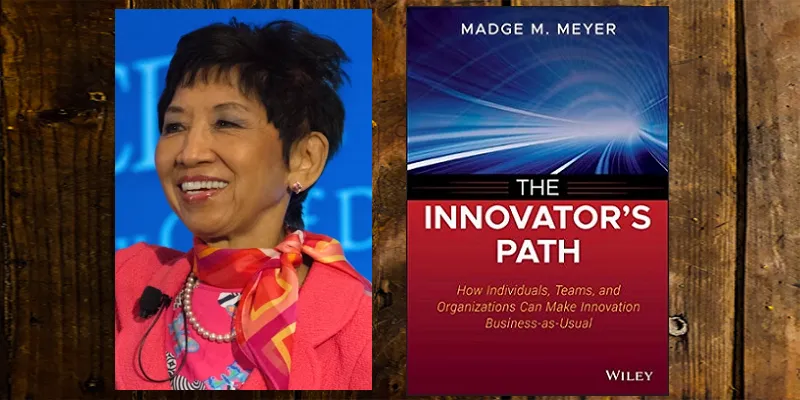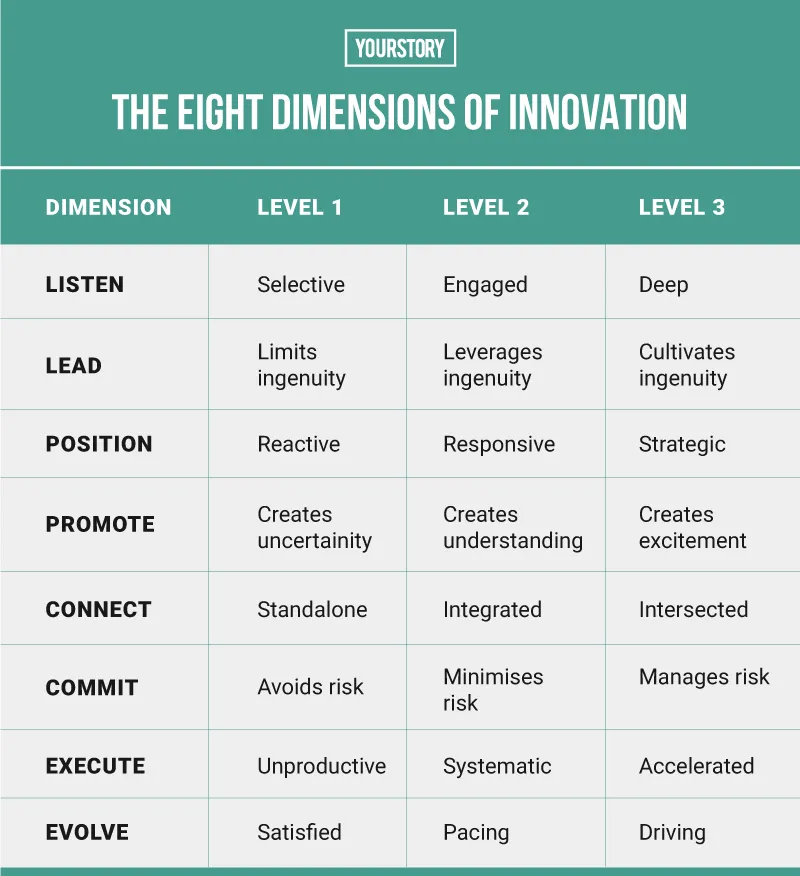Anticipate change, don’t just adapt to change – Madge Meyer, Author of ‘The Innovator’s Path’
This bestselling author shows how organisations can succeed if they nurture curiosity and experimentation among all employees, along with calibration of risks involved.
Madge Meyer is the author of The Innovator's Path: How Individuals, Teams, and Organisations Can Make Innovation Business-as-Usual (see my book review here). She was formerly the Executive Vice President and Chief Innovation Officer at State Street Corporation, and was earlier at Merrill Lynch and IBM.

Her useful book provides frameworks and maturity levels for eight disciplines of innovation: listen, lead, position, promote, connect, commit, execute, and evolve. The author goes beyond the usual focus on geniuses or mavericks, and emphasises that innovation can arise on any day and from any employee, and not just the R&D or strategy department.
In this chat with YourStory, Madge talks about balancing experimentation with risk management, effective partnerships for innovation, and leadership ability to spot contradictory and weak signals.
Edited excerpts from the interview:
YourStory[YS]: What are the typical challenges entrepreneurs face as they scale up their company? How can they retain their innovative edge?
Madge Meyer[MM]: The typical challenge is keeping the culture of innovation alive and continuing to evolve while also providing high-quality services efficiently and effectively.
Most innovators or entrepreneurs are very creative people, but might not be as good in administration and daily operations that require structured operational processes, methodologies, and so on. Effective innovators recognise their strengths and weakness, and partner with or hire a diverse team with different backgrounds and skillsets to manage different parts of the business.
They have to be sure, though, that the culture they create as they grow is one that continually seeks to improve and evolve. Innovators can lose their edge when they are happy with what they have done, and just ride the waves of their success to gain more customers and more revenue.
Innovators can become prisoners of their own success. If they forget to evolve and continue innovating, their competitors will win.
YS: How was your book received? What were some of the responses and reactions you got?
MM: My book was received well by a broad range of readers – from young, entry-level employees to senior executives at major global organisations. The message that everyone can be an innovator – not just those in certain departments or with certain job titles – had a broad appeal. When you think that way, every job suddenly becomes more interesting and full of potential.
The book’s focus on creating business value (increasing revenue or reducing expenses) really appealed to senior executives in business and higher education. They would often purchase copies for staff or students and invite me in to speak.
I have been invited to judge innovation competitions at MIT, Wharton Business School, and other industry groups, and I’ve been asked to become a Board or Advisory Board member for organisations across many different industries. In 2014, my book received an Axiom Business Book Award in the Success/Motivation/Coaching category, which was a great honour.
My favorite responses, though, are the individuals who contact me to say how the book has impacted them. Sometimes, one of the book’s stories really helped changed the way they look at things. Other times, people tell me how they used one of the book’s techniques to deal with a challenge, and succeeded because of it.
One woman attributed her promotion to CIO to what she gained from the book! It took me a lifetime to learn these ‘Eight Disciplines,’ and I get great satisfaction just knowing that others are benefiting from them.
YS: How should innovators strike that delicate balance between ‘Stick to your vision,’ and ‘Adapt to a changed world’?
MM: It’s all how you define ‘vision.’ An innovative vision is based on a sense of tomorrow. It recognises and accounts for the inevitability and speed of change. It seeks to understand the customer and market needs before the customer or the market even understands them.
Leaders and innovators must be open-minded, not stuck in the mud. The very best innovators don’t adapt to a changed world – they anticipate it.
YS: Is there such a thing as the ‘ideal age’ for an innovator, or can the creative bug strike you at any time? How should people nurture their innovative edge throughout life?
MM: There is no fixed age for innovators. Curiosity is the key to innovation. All kids have curiosity – this was how they learned. Those who never lost their curiosity have everything they need to create something new.
Innovation is often the result of someone just trying to solve a simple problem for themselves, and finding that others have that same problem. Khan Academy is a great example.
YS: It’s one thing to fail with a product, and a bigger dimension to fail with a company. How should founders regroup in these two situations?
MM: In my book, I talk about the notion of calculated risk. That means you have thought through the worst-case scenarios and have found ways to mitigate the risk and impact of failure.
You have a clearly defined limit for the funds you’re willing to lose, and you test your assumptions with frequent proofs of concept or pilots. It is critical to validate that you’re fixing the root cause of a problem or providing a product that your market wants.
Otherwise, it’s not a calculated risk – it’s just a risk. That holds true whether you are talking about products or companies.
YS: How should innovators evaluate weak signals and anecdotal evidence which seem to contradict quantitative market trends?
MM: Quantitative data is important, but it’s not enough. For one thing, it’s often telling you more about the past and present than the future. For another, if others have access too, it doesn’t provide much of strategic advantage.
Innovators are often very attuned to weak signals and patterns of anecdotal evidence. They LISTEN, as I describe in my book. Great leaders and innovators pay close attention to anything that contradicts what they believe or are told. They want to explore incongruities, not ignore them.
YS: What are the ‘Top Three’ success factors for government and industry to work together for innovation?
MM: First – establish a culture of innovation and spirit of collaboration and teamwork. A culture of innovation means people are open to change and new ideas. It means people are not afraid to take calculated risks and fail – as long as they fail fast within affordable loss. People should not be punished for testing new ideas by doing a proof of concept or pilot project.
Second – develop common goals and a shared vision of the future. Having a shared sense of tomorrow is critically important, yet it must be combined with a focus on short-term (monthly, quarterly, yearly) financial performance numbers. Having a strategic vision, positioning for sustainable market shares, and measurable goals are important for both government and private industries.
Third – establish an incentive programme by rewarding the team, not individuals for actual success based on agreed-to criteria. The criteria can be business value delivered, speed, zero-defect execution, and so on.
Collaboration is the best for innovation! There are so many opportunities for the government to collaborate with the industries for transformation.
The government should leverage current technology capabilities to transform and be more effective and efficient. There are opportunities in leveraging IoT, AI, deep learning, and other advances to make governments more efficient and effective.
Change is always hard. Cultural change is even harder. It is critical that all the leaders have forward-thinking and open-minded vision and practices.

Source: YourStory's book review of 'The Innovator's Path'
YS: From your journeys across Asia and other parts of the world, what are some emerging innovation strengths and gaps you observe?
MM: People – especially younger generations – are extremely excited about innovation across the world. There is no difference! There are innovators and entrepreneurs all over the world.
However, some countries or locations are more open to change and providing more opportunities for young people to learn and grow. Then, there are more successful innovators.
Innovative ideas often come from serving a need. In Asia, due to large populations in countries like China and India, the needs and opportunities are there for innovators to find the solutions. This is very exciting for younger generations to keep their minds open for these opportunities.
YS: What is your parting message to the innovators and aspiring entrepreneurs in our audience?
MM: I like to use this saying which was given to me a long time ago. I was told it was said by a West Point General to sophomore cadets:
“Risk more than others think is safe.
Care more than others think is wise.
Dream more than others think is practical.
Expect more than others think is possible.”
I urge people to recognise that everyone can be an innovator if they have the spirit of curiosity, a focus on business value, and the willingness to take calculated risks.
Keep dreaming! Keep innovating! The best is yet to come!!
Edited by Suman Singh








